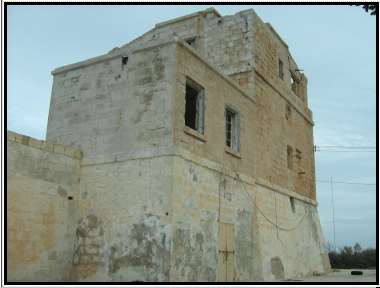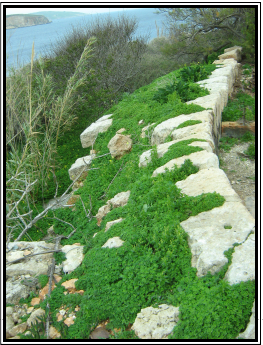L-AĦRAX TOWER COASTAL BATTERY
L-Ahrax battery was initiated in 1714 with the financial assistance of Knight Commander Mongontier who donated 1323 scudi for the construction of five coastal batteries along the Fliegu coastline. By 1716 another 544.11.10.3 scudi were paid out to cover the construction costs. It was a gun battery built around L-Aħrax tower. The battery consisted of a semi-circular gun platform with an en barbette parapet, a blockhouse that was built on the western wall of the tower, and two walls linking the tower to the gun platform. It was surrounded by a rock hewn ditch.
The Hospitallers’ list of expenses for the building of such coastal batteries and redoubts in 1715 and 1716, in the L-Aħrax Battery is stated that there were musketry loopholes. However, the blockhouse lacks any visible evidence of musketry loopholes, this might imply that some sort of enclosing walls were built, which in turn where pierced with such loopholes.

L-Aħrax Tower was constructed in 1658. It was the sixth such edifice built by Grand Master Martin De Redin.

Part of the left part of the parapet of the gun platform.
According to the 1761 plan the arrangement of the tower, the blockhouse, the enclosing wall and the semi-circular gun platform do not quite correspond. The tower was not arranged in a diagonal way with respect to the semi-circular gun platform, the enclosing wall is in the wrong position, and the 1761 plan fails to show the appearance of the blockhouse clearly. The 1761 plans almost invariably provided exact and correct details about the various coastal batteries and redoubts. It seems that L-Ahrax Battery, may be an exception.
During the construction of these batteries, the military engineers experimented with various forms of blockhouses and redans. Most of the batteries, had a free-standing musketry wall with a projecting redan, often fitted with blockhouses, but the L-Aħrax Battery lacked such a feature, due to the fact that the gorge walls appear to have connected with the tower in such a way to leave one of its sides completely exposed to the enemy. This is why most batteries employed the V-shaped redan trace in order to eliminate such a threat. It would seem then, that the gorge walls of the L-Aħrax Battery were mainly added simply to enclose the gorge and protect the gun-crew from incoming shots, and were designed to work more in the form of flanking traverses rather than defensible perimeter walls.
Due to the inspection visits performed during the 18th century, we know how the L-Ahrax Tower was armed and equipped. In fact, a visit in the coastal towers by the by the Giurati of Valletta and Mdina on 18, 19 and 20 June 1743, indicate that there were the following:
Thirty years later, in 1770, an artillery inventory was prepared. The following is a list of what was found in the tower and battery:
L-Aħrax Battery
Iron cannons 12-pdr = 10
Naval carriages = 8
Iron cannon balls 12-pdr = 700
Grape shot 12-pdr = 150
Blackpowder conserved in St. Agatha Tower.
An artillery inventory was prepared by the Knight St. Felix on 3 October 1785, which showed the situation in the same coastal fortifications and how many pieces of artillery and other utensiles and necessary items they had. The following is the list of artillery pieces in L-Ahrax Battery:
L-Aħrax Battery or Lespinas Battery
Iron cannons 12-pdr = 7
Naval carriages = 8
Iron cannon balls 12-pdr = 190
Canister shots 12-pdr = 105
In early November 1792, a number of artillery pieces of different calibre were distributed in various coastal fortifications, some of them in the coastal fortifications of Mellieħa. The following is a list artillery at L-Aħrax Battery, the calibre of the guns and their number: